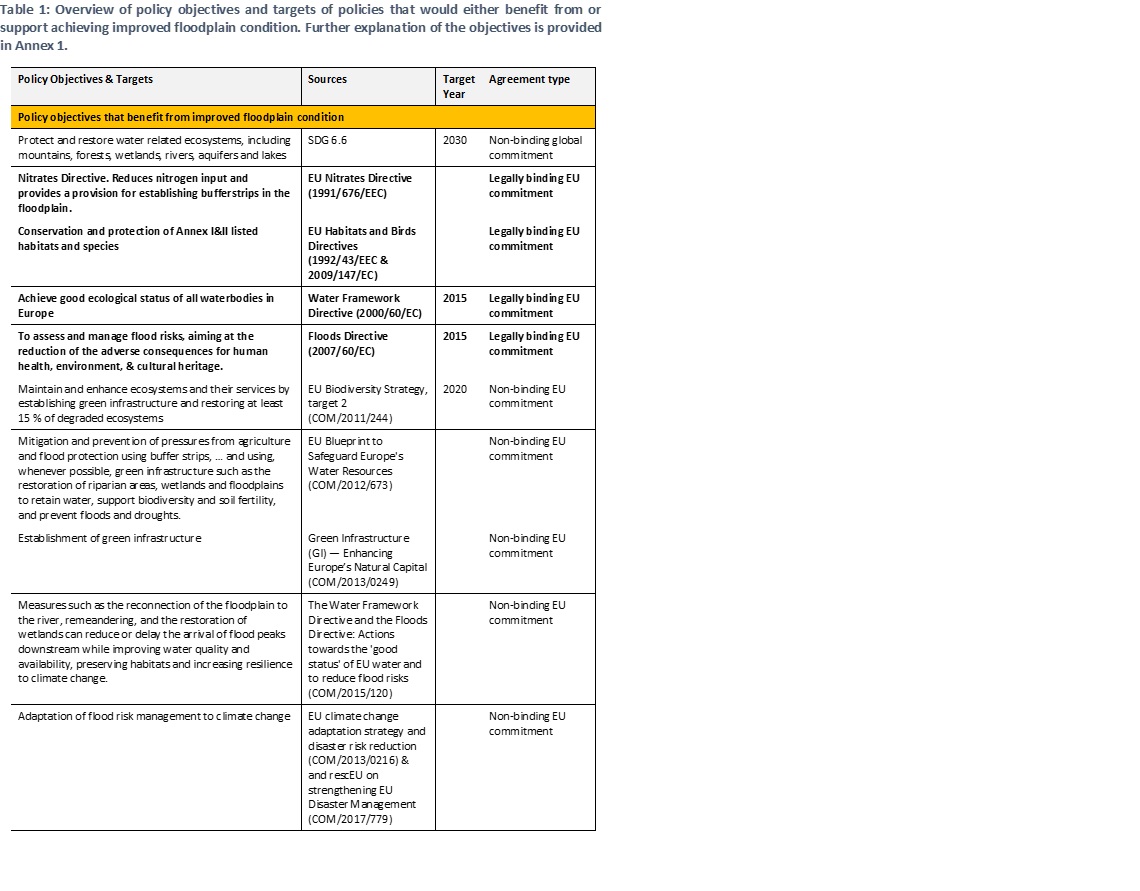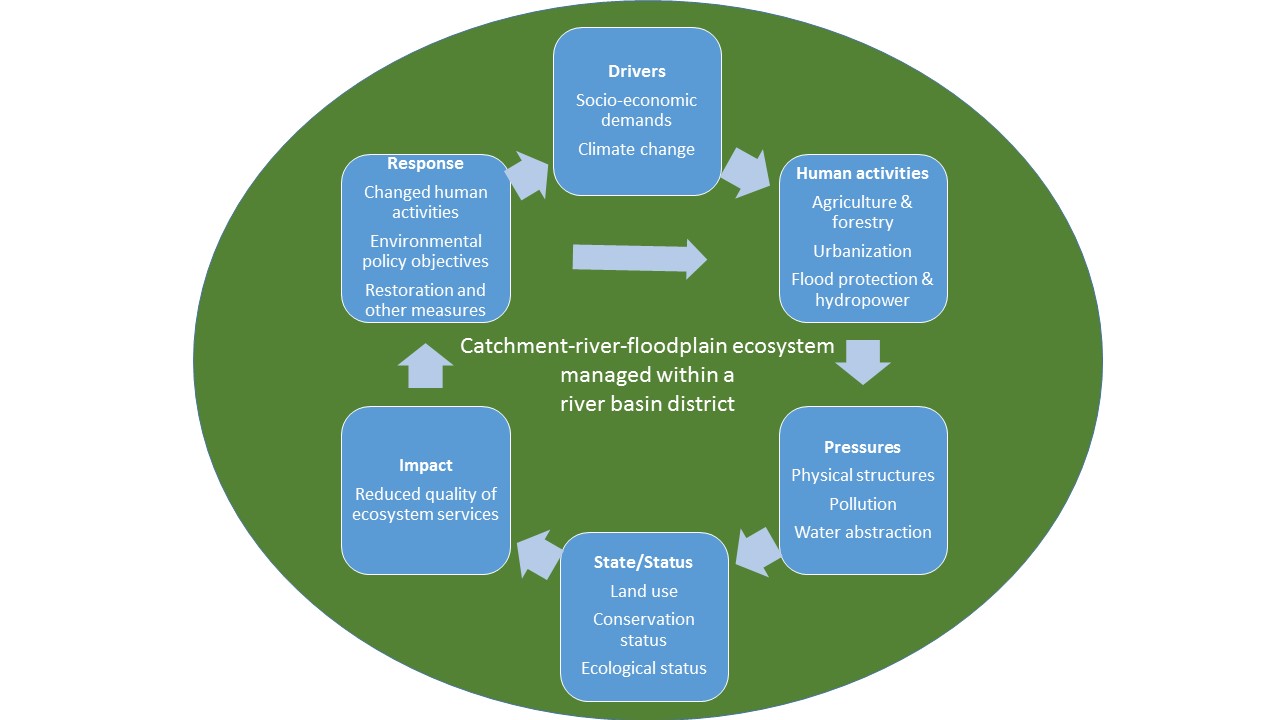Table of contents
- Draft key messages
- Executive summary
- 1 Introduction - 1.1 Scope of theme: Why care about floodplains?
- 1 Introduction - 1.2 The catchment-river-floodplain ecosystem and policies
- 2 Floodplains under pressure - 2.1 Floodplain characteristics and extent
- 2 Floodplains under pressure - 2.2 Current floodplain status in Europe
- 2 Floodplains under pressure 2.3 - Climate change and altered flood risk
- 2 Floodplains under pressure - 2.4 Hydromorphological pressures and alterations
- 2 Floodplains under pressure - 2.5 Pollution pressures
- 3 Improving ecosystem services and measures - 3.1 Ecosystem services
- 3 Improving ecosystem services and measures - 3.2 Measures
- 3 Improving ecosystem services and measures - 3.3 Examples of river and floodplain restoration
- 4 Managing from an ecosystem perspective
- 5 Conclusions and Outlook
- References
- Annex 1 European and Global Policy Context
- Annex 2 Definitions
- Annex 3 Ecosystem service overview
- Annex 4 Measures that improve services
1 Introduction - 1.2 The catchment-river-floodplain ecosystem and policies
In their natural condition, rivers and floodplains are laterally connected, exchanging water and nutrients in a shared ecosystem. Thus, floodplains act as a buffer between the catchment and the river; its quality is closely linked to conditions in the river as well as within the catchment. Many of the human activities that develop pressures on rivers and the floodplain need to be managed at catchment scale, while the specific impacts are observed in the river and floodplain. Changes in river flow, sediment input, forestation, agricultural activities, and urbanization all have the ability to change conditions in the river and in the floodplain, ultimately affecting both aquatic and floodplain habitats (Schulz et al., 2015). In addition several studies have shown that if ecosystem improvements occur in the river system, it will also lead to improvements in the floodplain (Januschke et al., 2011; Hering et al., 2015; Göthe et al., 2016). This inter-connectedness underlines the importance of considering the catchment-floodplain-river ecosystem as a whole.
Natural, undisturbed floodplains are areas of very high biodiversity; they support habitats and species that have adapted to the unique environmental conditions provided by the cycle of flooding and drying, and they provide intermittent habitats for water dependent species. Flooding and water-logged soils are important properties of a natural wetland. Both water and substrate properties are highly dynamic, creating a multitude of ecological niches in permanent exchange with the river and its catchment area and act to form ecological resilience over time (Fuller et al., 2019).
In Europe, almost all rivers and their floodplains have been disturbed by artificial interventions. Adjustments happen in a multitude of ways that depend on conditions in the particular river basin, and often continue over years, calling for both increased focus on river basin management. The need for management and restoration of the catchment-river-floodplain system is, however, widely recognised in EU policies. The overview provided in Table 1 shows the many policies that either depend on restoration to achieve their objectives, or encourages restoration through specific mechanisms such as green infrastructure. The Water Framework Directive, with its objective of reaching good ecological status for biological quality elements linked to aquatic fauna and flora, and its recognition of hydromorphology as a pressure, is a very important driver for such improvements.
The Water Framework Directive also operates with hydromorphology as a supporting quality element, i.e. for surface water bodies not achieving good ecological status, hydromorphology needs to be assessed, and significant hydromorphological pressures are identified. Moreover, important policy instruments are already in place to secure that new initiatives in rivers and floodplains do not negatively affect the status of environmental objectives.
Both the Water Framework Directive and the Habitats Directive provide provisions for preventing further degradation. The Water Framework Directive article 4(7) requires that only new projects that do not risk altering the waterbody status are authorised. New projects that involve e.g. hydromorphological alterations or alterations of the groundwater level must be developed in a way that waterbody status is not lowered. Similarly, new projects that could impact protected sites (e.g. Natura 2000 sites) designated under the Habitats and Birds Directives also need an appropriate assessment of impacts according to article 6(3) of the Habitats Directive, and primarily only plans that do not adversely impact the site of concern can be approved. Europe’s Floods Directive requires all EU member states to develop flood risk management plans that include an assessment of areas of potential flood risk, and evaluation of assets at risk with the specific objective of reducing the adverse effects associated to human health, the environment, cultural heritage, and economic activities.
As a cross policy initiative, Target 2 of EU 2020 biodiversity strategy requires restoring at least 15 % of degraded ecosystems by 2020, and increasingly, implementing restoration approaches based on green infrastructure principles is seen as best practice solutions. Such solutions enable achieving multiple environmental policy goals: they enhance the delivery of ecosystem services and in return for this improvement they support the delivery of good ecological status, good conservation status and improved flood risk management. Hence, the Water Framework, Floods, Birds and Habitats Directives in combination act as drivers for river and floodplain restoration efforts, even if their management plans are developed with differing objectives in mind. More recently, the importance of river restoration has been acknowledged at the global level with the adoption sustainable development goal 6.6.

While the policy overview shown in Table 1 is comprehensive, it is also fragmented with many different approaches taken to managing environmental concerns within the catchment-floodplain-river ecosystem. Presently, floodplains are recognised in the context of the Water Framework Directive, but they are not systematically assessed as part of river basin management plans, although an ecosystem based perspective suggests this could be highly relevant.
Ecosystem based management refers to a system for managing multiple human activities and their pressures, that aims to ensure that the ecosystem is healthy and resilient while at the same time delivering the services that people want and need (McLeod and Leslie, 2009). Defining the catchment – floodplain – river ecosystem provides a unifying concept for managing across the policies listed in Table 1. It also demonstrates that there are benefits to including a broader perspective on the notion of rivers than currently captured in river basin management plans. Because floodplains are at the interface between the river and the remaining catchment, their condition is critical for the over-all ecosystem health, i.e. as status of water in the river, for flood protection and water retention, and for biodiversity.
Some of these principles have already transpired into European legislation. The management units of the Water Framework and Floods Directives are river basin districts, which to a very large extent overlaps with catchment boundaries. However, biodiversity management, takes a different approach, operating at the geographical scale of biogeographic regions. Many habitat types and species, however, also depend on water and wetland availability which is often associated with rivers and floodplains; 50-60% of the terrestrial Natura 2000 sites are found within floodplains. For these habitat types and species, relevant management actions for their improved conservation, could benefit from being linked to an overall approach to water management.
To make ecosystem based management work, it needs to also encompass collaboration between all institutions that have governance responsibilities for human activities together with transparent stakeholder and adaptive management processes (Rouillard et al., 2018). As captured by the drivers-pressures-state-impact-response framework (Figure 1.1), it is not enough to identify environmental pressures, state and impact, a shared plan for their solution also needs to be developed, evaluated, and readjusted over time. This planning establishes the need to reconcile many different priorities for human activities while maintaining a healthy ecosystem as key to environmental management decisions. Solutions for achieving the multiple policy objectives listed in Table 1, can often be the same, and often need to be established in floodplains. If well planned they can lead to over-all improvement of ecosystem health in rivers, floodplains, and eventually the entire catchments. Measures, however, often aim at addressing specific human activities, but to achieve societal buy-in to implementation, the overall link to socio-economic demands also needs to be addressed. The drivers-pressures-state-impact-response framework outlined in Figure 1.1 is used for reference throughout the remaining report.
Figure 1.1 DPSIR analysis framework for floodplain ecosystems



